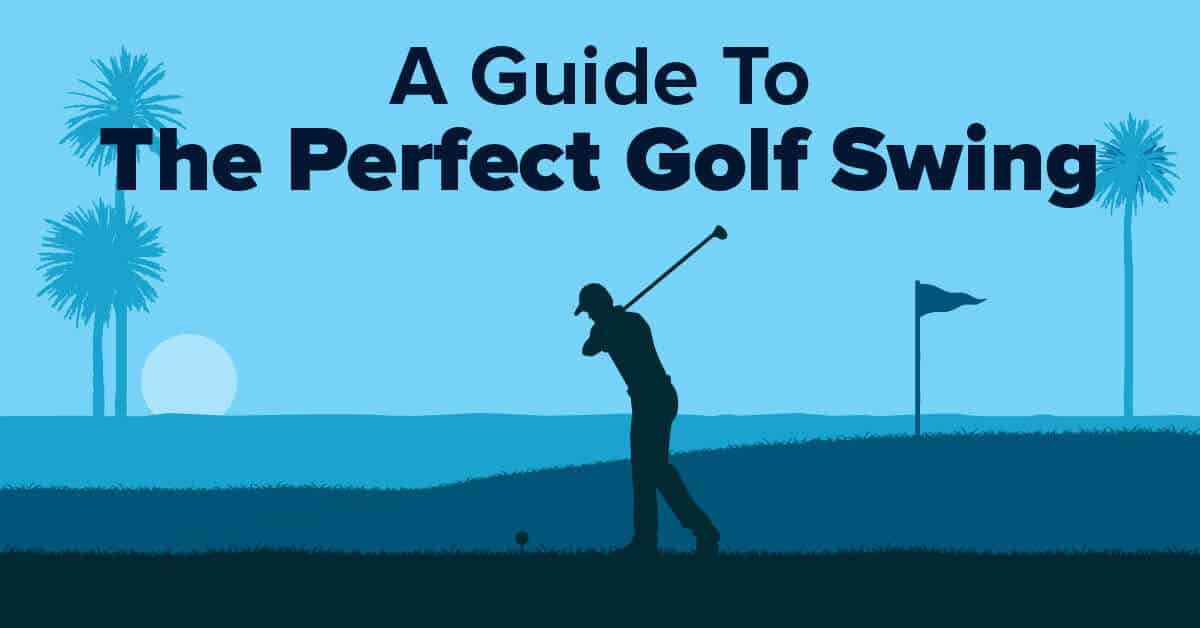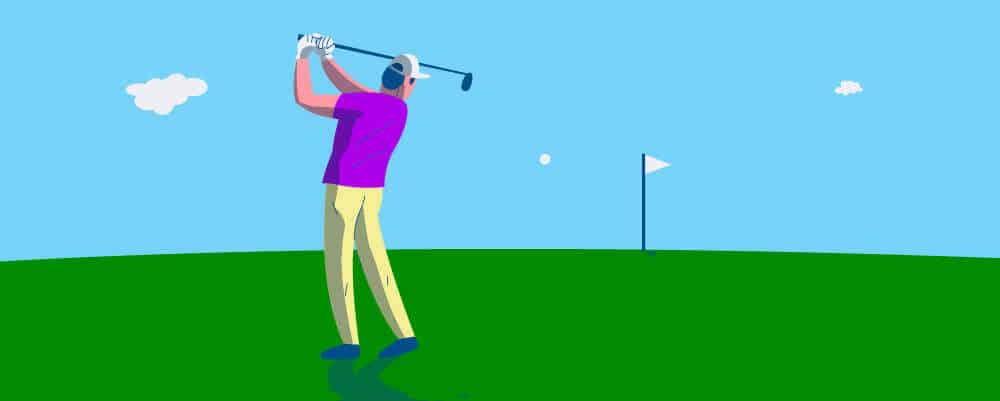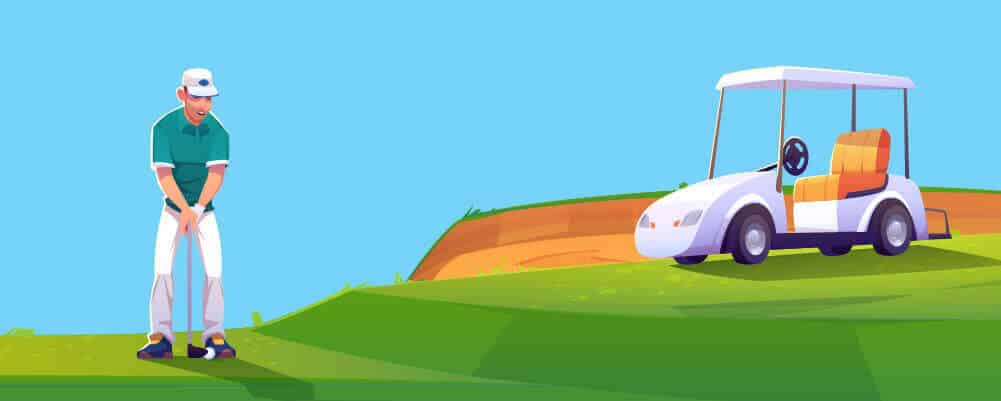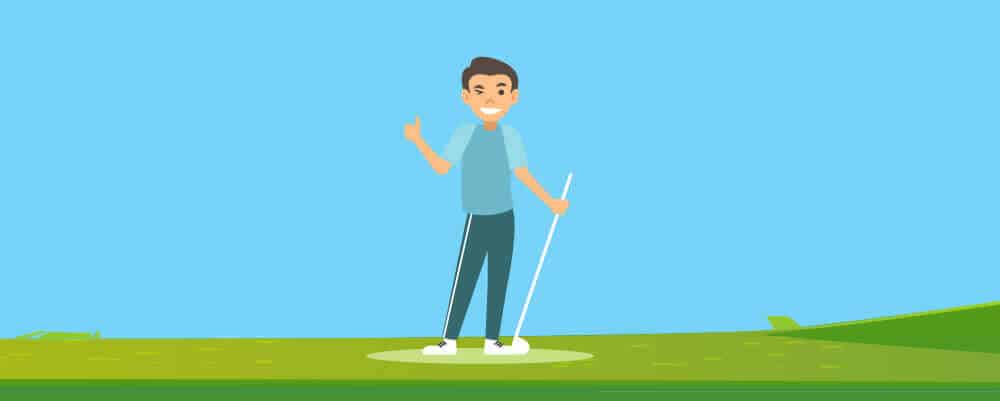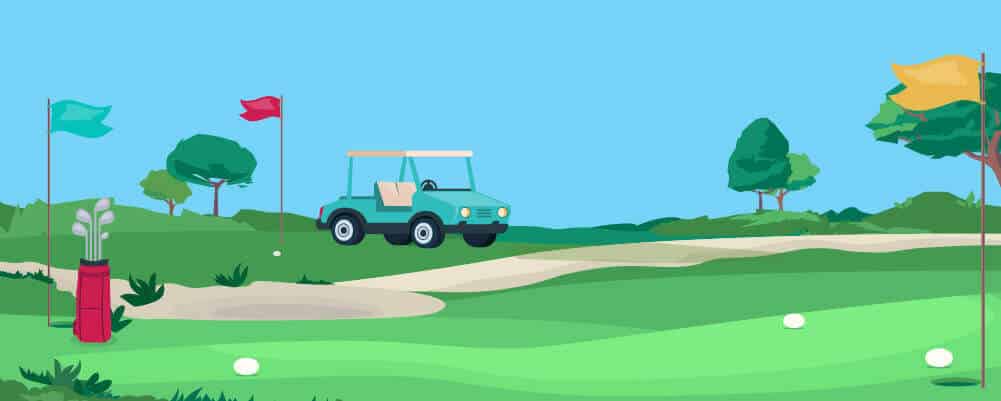Introduction
So it’s time for your next golf game. Perhaps you’re going with friends and family, or maybe you’re going on a big trip with your coworkers or clients. One fact remains – you want to impress the next time that you hit the greens. You don’t want to be getting terrible scores and getting shown up by the other players, after all. You have a reputation to uphold!
The truth is that golf can be a fairly complicated sport, especially for people that are still new to the game. A rookie may not know his handicap from his driver, but that has to change if you want to get ahead in the game of golf.
One of the most fundamental things that any aspiring golfer has to learn though is about the golf swing. If you have a poor swing then how do you expect that you’re going to get the results that you want? If you already know the answer to that question and you want to make some changes, then you have come to the right place. As golfers ourselves, we know all about how to make your golf game better, and that starts with your swing. As such, we’ve devised this guide to give you all of the information that you need in order to create the perfect golf swing.
Table of Contents
The Basics Of The Golf Swing
Now, let’s start at square one. Here are a few of the basics of the golf swing that you simply have to know about before you get started to ensure you have good golf technique.
Grip is important
Oh, the grip. If you don’t get a grip, then how are you going to have a good swing? That’s right – you’re not.
So why is the grip of your club so important in the game of golf? It ultimately comes down to control. If your hands are positioned in the correct manner then you will find it significantly easier to be able to control the club face when you hit the ball. This allows you to send the ball in the right direction, without the ball ending up behind you, or to your side in your friend’s eye (Happened to a friend of ours once – we do not recommend it!). You will have more fluidity in your wrists as you move too, and the strength at which you hit the ball will be massively improved. All the fancy drivers and 9-irons in the world won’t mean a thing if you don’t have your grip nailed down.
There are three main kinds of grip that you will often hear about in gold – it’s strong grip, weak grip or neutral grip. They all have their benefits in certain situations and depending on your needs at the time.
A strong grip is good if your hips stay open to a target when you are trying to hit a ball – it’s usually best to have a strong grip with your left hand if you are a right handed player.
A weak grip, on the other hand, is best if you don’t tend to have your hips open to the ball. You’ll have an advantage with a weak grip in this situation. It’s usually best to play around with different grips to see what works best for you.
Fix the slice
When you have your grip sorted, you’re going to then need to work on the slice. A lot of players, especially newbies, have huge issues with slice because they try to get the ball to go in one direction, but it just goes awry instead.
Of course, there’s a problem. If you want to fix the slice then you are going to need to know what exactly is causing the problem to begin with. There’s no specific answer as to why you are slicing – it could be because you are coming at the ball at the wrong angle, or because you are standing too close to it. Make some minor adjustments in order to get the best results. If you aren’t sure what the problem is then it’s worth speaking to a professional to see if they have any guidance.
Fix the hook
You’re also going to want to fix your hook. The hook is basically when the face of the club and the path it’s moving in has a massive difference, and this can cause the ball to end up in a totally different direction from what you intended. If you can sort this out, in addition to the other things mentioned above, you are sure to get a golf swing that you can be proud of.
Getting Started: Address & Set-Up
Now that you know the basics, you’re ready to get started on creating the perfect golf swing. It may not be easy, but if you can master it then you can ensure that you hit the ball with power and accuracy every single time.
Involves the correct position, before the the swing begins
Before you can start swinging and taking aim, you will first need to get yourself in the ideal position to take your shot. Dealing with the address and set up of the shot is fundamental to your swing, so this isn’t a step that you will want to be missing!
The main thing that you need to know is that in order to get a good swing, the main thing that you need to do is ensure that the club is resting flat on the back of the ball. You need to ensure that you are holding the club correctly, and that your posture is correct with knees bent in the right angle, and upper body tilted forwards and straight.
So, let’s take a deep dive into what makes the ideal address set up and position. If you watch the PGA Tour on TV, you can really learn a lot about the correct setup and it will help you to visualize what you need to do.
You should start out with your body straight, and make sure that your feet are positioned around a shoulder’s width apart. As you have done this, you should then start to bend the knees a little. Not too much, but it should look like you are beginning to squat. The hips should be pushed back – don’t bend at the waist. It should feel like you’re trying to show off your rear to the world!
Now you need to work out what you’re doing with your arms. Don’t go all stiff – you’ll want to keep your arms hanging straight in front of you as you hold the golf club. Make sure that the club is aligned with the ball and will be going in the right direction. It can help to look into the ball position too in order to further perfect your stance.
As a quick summary, it’s important that the ball is positioned right in front of you and should be nestled in the middle of your feet. The ball needs to be closer to you if the club is shorter so that you can reach it properly without messing with your posture and stance.
It’s important to note that if you are hitting the ball using different clubs then your stance may need to widen. For instance, if the club is a driver which is quite long, your feet will need to be further apart than if you were trying to use something like a wedge which is much shorter. The feet alignment can change a lot depending on where you are aiming for the ball to go. A parallel stance to the target line is important if you’re trying to get a straight shot, whereas your feet should be positioned towards the left if you are aiming for something more precise that’s quite a distance away from you.
If you are struggling to get the right posture and stance before hitting the ball, there are actually tools that can help you to get it right such as the Alignment Pro. It can sometimes help to get someone who’s more experienced in golf to take a look at what you’re doing too, since they can give you some guidance about whether you’re doing things correctly and can give you some tips and tricks that they may use.
Perfecting The Backswing – The Golf Takeaway
Now that you have your stance and posture all ready, it’s time to take your shot and acclimatize to the backswing. But how should you best execute the backswing? Here’s what you have to know.
The Right Stance
First of all, let’s talk about your arms and heels. When you begin the takeaway, you need to ensure that your left arm is straight. Likewise, the left heel should stay in the ground. The exception to this is if you need more flexibility and you simply have to change this. You may feel a little weird when you’re standing like this and taking your shot, but it ultimately leads to much more powerful shots because your upper body isn’t twisting as easily. Your right knee should remain flexible and keep it in the same angle you’ve had it in since you prepared yourself in the address earlier on. Your left knee needs to bend towards the ball so your weight moves onto the right leg and gives you more power when striking.
When thinking about your hips, make sure that they rotate to align with your arm, but you need to ensure that they aren’t sliding back. Your pelvis should be rotating away from the target as you take your backswing, and moving back to their original position as you follow through. When your pelvis rotates, you will begin to feel the weight moving towards the heel of the foot in the rear position. You may need to play around a little with your position to get this effect since it can vary depending on the person. This is partially why it’s a good idea to get a coach to check what you are doing since they can advise on what will work best for you.
As you are taking your backswing, you need to have your spine at a 45 degree angle and don’t press the chin into the neck – it needs to be free but focused. You should not be in a position where your head is moving a lot when you are doing your backswing. The problem with moving your head a lot is that your spine will change its angle, which can throw off the entire swing. Keep your head still to keep focus and position in check.
When taking your swing, you should be primarily using the larger muscles in the arm rather than the smaller ones. In this case, you’re not using the wrists to take your swing, you’re moving the entire arm and leaning on the strength of your shoulders and core.
Not Too Hasty! Take Your Time During the Backswing
Make sure that you take your time, too. If you have to take a couple of practice swings to feel reassured that your alignment is correct, there’s nothing wrong with that. There’s no rush, and trying to do things too quickly may mean that you’re more likely to have a shot that goes wrong. You won’t get a more powerful backswing just from going fast either, contrary to popular belief. Your backswing always needs to be lower than the downswing, which ideally needs to be faster in order to get the right level of power when you hit the ball.
Setting up the perfect backswing position is vital in order to ensure that your downswing has the maximum effect.
Tips For The Top Of The Swing
Before you hit the ball with a backswing, you first need to reach the top of the swing. This is the middle point between when you take your initial stance and when the club makes an impact with the ball. It’s pretty important that you get the positioning right here in order to get the best results.
Left wrist should be flat at the top
When you get to the top of your wrist, it’s important that the left wrist is positioned flat at the top. It needs to be completely hinged at an angle that’s around 20 degrees from your body. The wrist should not be contorted in bizarre positions, looking cupped or bowed. If you have the wrong wrist position it can often mean that you end up slicing or hooking the shot. This is not ideal if you want to get good scores and not make a fool out of yourself in front of your competitors. Instead, the wrists need to be hinged towards the rear of the swing as it starts to be aligned with the ground below. This minimizes the chances of side spin.
Shaft of the club should point towards the target
Likewise, it’s also important to ensure that the shaft is positioned correctly at the top of the swing. Consider the direction that the club is facing in. There are three main directions to consider when the club becomes parallel to the ground.
First is the left of the target and right of the target. In the middle is when the club is pointing right at the target.
It’s not hard to figure out which one is the ideal direction for your shaft to be pointing in. It should be pointed towards the target when you’re at the top of the swing. Then, as you release the swing it will stay straight on the downswing and will stay in a straight line.
When you’re at the top of your swing, your arm should be in the correct position too. The front arm needs to remain straight, though not in a locked position. Don’t be afraid to add a little bit of bend if you need to, just not too much that it impacts your swing. Then, the back arm needs to be bent at the top and should remain close to the side. Make sure that your elbow is pointing towards the ground.
If you are struggling with the top of the swing, there are actually drills that you can do to improve it. Drills are helpful since they help your muscles to get used to the movement, so it’ll become natural for you in the future.
Executing the Downswing
Now comes the final part of your swing – the downswing! This is a vital part, since it’s when you will finally come into contact with the ball. The amount of force that you exert on the ball is determined largely by the accuracy of your downswing, so you’ll need to work on getting it right.
If you get the downswing right, it achieves a few different things. First of all, it helps to ensure that the path of the club is square so that you will center on the middle of the ball, helping it to go straight as it moves. It also controls the club face’s loft and the attack angle. If you get the downswing wrong, however, you can get some pretty ugly results.
What ultimately matters the most with a downswing is that you have a fluid motion with the correct posture. It may be tempting to try to put all of your upper body into your downswing, but in reality you should really lean more on your lower body to get the results that you are looking for.
The fact that’s worth remembering is that your arms and your hands are naturally going to try to follow where your body is going as you execute the downswing. When you are doing the downswing, you should ensure that your weight is shifting slightly, your pelvis and thorax are rotating, and your shoulders, forearms and the ulnar deviation should be rotating as you swing through. Many beginners to golf struggle with these movements.
Body Movements
Again, you will want to ensure that your wrists are hinged in the correct manner in the top of your swing before you start the downswing. They need to stay this way as you are following through to reach the end of your swing. Don’t unhinge them until you reach the ball, otherwise you won’t swing correctly and the energy transfer won’t be maximized. This will lead to some pretty embarrassing results that are best kept off the golf course!
You’re also going to need to reverse what you did during the backswing. Your body will be moving in the opposite direction to its initial movements during the backswing. As you move through the swing, the weight needs to be back onto the left foot. Don’t do this too quickly, and allow it to be a natural movement that follows how your hips and shoulders rotate. As you are practicing, allow yourself to truly feel the re-distributed weight, and feel that the head of the club is pointing to your rear as you are swinging.
Don’t let your back elbow start lifting upwards from your side – it needs to stay there during the downswing so you can keep the level of power that you need to properly execute the swing.
The Moment of Impact
Ultimately every golf swing needs to end in impact and – unsurprisingly – there’s a right way to do this, too. The club needs to be square with the ball when you are making an impact during the downswing, regardless of what club you’re using. Although, if you’re using a driver you should be hitting it when you are back on the upswing. Don’t try and get your club underneath the ball to lift it into the air, as this can cause all sorts of problems.
When you have made contact with the ball, it’s still important that you keep following the ball through afterwards. This will help you to know that the ball has been lifted off the ground correctly so that it can go the distance that it needs to go. Focus on your upswing and follow the movements. Now your swing is complete and you just need some repetition to starting hitting your irons straight and driving into the fairway consistently.
How To Build The Perfect Golf Swing
So now you’ve heard the long story about how to build the ideal golf swing. Now what? Now, we summarize!
Use your lower body to create a powerful backswing position
Many people focus solely on their upper body when they’re playing golf. After all, why wouldn’t you do so when you’re using a club that’s being held in your hands? A player may believe that they need to twist and contort their upper body in all sorts of shapes in order to hit their target, but in reality this simply isn’t true. In truth, your lower body is just as important for creating a powerful swing as your upper body, perhaps more so in some respects.
For starters, you will want to ensure that your hip movement is correct. You hips will rotate slightly as you move if you are doing your backswing correctly. It can sometimes help you to think that the shaft of the club is going right through your waist as you are moving so that the club is pointing towards the ground at the top of your swing. If you get the hip position right at the backswing, it’ll naturally follow your movements as you work through the rest of the swing.
Most importantly of all is the footwork. You don’t need something fancy for your footwork, just something accurate. Make sure that the feet have the correct stance around shoulder width apart, slightly bend your knees and position the ball in the center in front of you.
Try to ensure that you aren’t swaying backwards a lot when taking your swing, as the movements involve twisting rather than swaying. Swaying won’t create power – it’ll usually just cause problems. Don’t lift your heels at the wrong time, and keep the rear foot in the right position.
Posture is important
As we’ve established throughout this article, your posture is vital to creating a good swing. It’s important that you check that you’re doing it correctly – even if you have to watch yourself taking practice swings in the mirror for a few hours every day.
Posture is important for numerous different reasons, including ensuring that you have the correct balance when you are hitting the ball. Without good balance, you may struggle to correctly hit the ball.
As a brief recap, remember the following points. Keep your back straight when you begin the backswing and as you follow through, keeping your arms relaxed rather than tensed. Make sure that you’re holding the club at the height of your waist and tilt slightly forward from the hips. Bend your knees a little, ensuring that the weight lies on the ball of your feet, and stand shoulder width apart.
If you don’t get your posture right, it can cause some problems. If your muscles are stiff then it means you’re putting extra pressure on the spine, which changes your upper body posture. If you don’t have the right flexibility then the same problem can arise. If you don’t stabilize your core then that can have problems too.
If you have the right posture, you’re more likely to get the right results. It’s worth keeping that in mind.
Lower body action is important to master club face control
Finally, remember that your lower body helps you to remain in control of the club face, especially during your downswing. If your lower body action is wrong and the weight isn’t being distributed down there correctly, you could lose your balance or totally lose sight of the ball. This is something best avoided – get your lower body action in shape!
Quick Tips to Remember
Still feeling a little lost? Here are a couple of extra tips to help you out!
Watch the Club Hitting the Ball
This may seem obvious, but make sure that you are watching as the club hits the ball. Some people don’t do this, and it negatively impacts their game. If you are watching what you are doing then you are far more likely to make effective contact with the ball which is what you need in order to get a good score.
Know Your Weaknesses and Strengths
It can often be hard to know where your strengths and weaknesses lie when you’re a new golfer, but it’s worth trying to figure them out. If you know what they are, then you can use them to your advantage. Every single golfer has weaknesses, even Tiger Woods. The difference between a good golfer and a poor one is that they recognize their strengths and they play to them. If you don’t think that you can hit a certain shot, it’s okay. Stay away from shots that you struggle with for a little while until you can practice and master them. After some time, you’ll find it a lot easier to deal with these challenges.
Have Patience
If you want to execute the perfect golf swing, don’t rush. We’ve said it before, but rushing the swing will simply lead to clumsy mistakes. Instead, keep your eye on what you’re doing and take your time to get everything right before you take your shot. It will be worth it when you see the scorecard later on.
Summary: Start Swinging!
Now you know everything that you need to know about how to be a pro at the golf swing! Are you ready to hit the golf course? With the tips and advice listed above, you will soon be able to hit the ball like the best of the golfers out there!
- Should Tee Boxes Be Level? - January 23, 2024
- 3 Hybrid Distance - November 15, 2023
- Innovations in Golf Mobility: An In-depth Review of Top Golf Scooters - October 12, 2023
